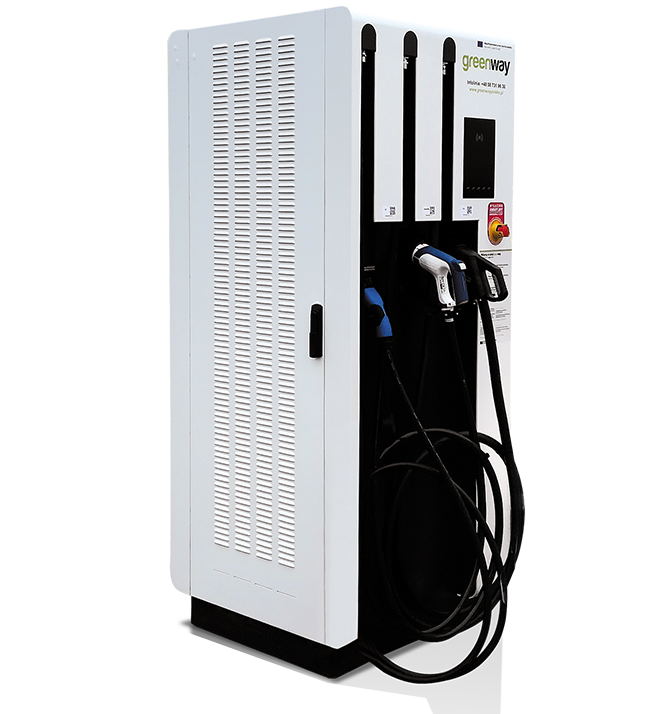Chargers
Among chargers, we can distinguish between normal and semi-fast chargers as well as fast ones. Slow and semi-fast chargers are more advanced than a simple home socket. Although they use alternating current (AC) for charging, which you will also find in the home socket, they enable you to increase the charging power up to 11 – 22 kW, which allows you to shorten the charging duration several times. Such chargers can easily be installed in your garage, there are many options on the market and the cost is not excessive.

Fast charger requires high power
Fast and ultrafast chargers are far more advanced. Because fast charging uses direct current (DC), these devices must first convert AC to DC, which can charge batteries with much more power, and therefore in a short time. Fast chargers can charge from 50 kW – 130 kW. The AC / DC converter is part of the charger. DC charging requires proper electrical installation, which can support the high power consumption. Most households do not have such connections. These types of chargers are also very expensive devices. Fast charging stations are used when we need to recharge the car during the day, especially when travelling.

Fast charger communicates with the car and is part of the IoT
Charger connectors have built-in pins, allowing the charger to communicate with the car, or actually with its BMS (Battery Management System). Thanks to this, the car informs the charger how much power it can take which adjusts its level to the current state of the battery, which helps to preserve battery life and prevent overheating.
What’s more, most chargers in the world are supported by charging network operators. The operators connect their devices to the Internet of Things (IoT), and each of the chargers communicates with the IT system by sending various types of data – how much energy does the vehicle take, which connector is used and for how long. To use stations located in such a network, you must have an account with the operator (or a roaming partner). All operators require user authorization at the time of charging to know who is using the device at any given moment. Authorization is also usually required to complete charging – without this, you cannot unplug the connector from the car. Authorization is done by a mobile application or an access card issued by the operator to a specific user.
Different charging standards
Fast chargers look a bit like gasoline distributors. They are equipped with cables and plugs, Almost all support at least one of the generally available charging standards: CHAdeMO, CCS (Combo), AC Type 2.
The CCS (Combined Charge System) standard, also called Combo, was developed by American and European car manufacturers and is used, for example, in BMW i3, Hyundai, Volkswagen and Chevrolet. It is more advanced than CHAdeMO and allows you to charge up to 350 kW, which is currently only available in select electric cars. At the moment producers are working on more models that will be able to handle such power and will appear on the market in 2019.
AC Type 2
Some electric vehicles cannot be charged by DC power at all- they can only be charged by AC. Chargers that provide support for all standards and can be used by all drivers also have an AC Type 2 connector to enable charging such EV models. This standard allows charging with power up to 43 kW, but the final power depends on the BMS of the car.
Tesla, an American company that some years ago decided to master the electromobility market and has created the most advanced model of a passenger electric vehicles with a large, even 100 kWh battery, decided to create its own chargers and charging standard. The company build its own a charging network, but because its solution is a bit of outsider, Tesla has introduced adapters that allow owners of their cars to charge at other operators´ stations.
GridBooster
Energy storage technology in this context (for GreenWay, the GridBooster system), involves two 50kW fast chargers supported by an auxiliary battery pack and energy management system. This allows temporary parallel charging of at least 2 vehicles with 50kW. Energy storage technology has many benefits, especially grid stabilization and flexibility and the easy integration of locally produced, renewable energy.
Energy storage is a new technology, just developing. A limited number of technological solutions are available on the market, and most of them are either still in development or the pilot phase. The inclusion of energy storage within these projects will be among the first implementations of this scale in Europe at all.
Contact Poland
GreenWay Polska Sp. z o.o.
ul.Łużycka 3c
Gdynia 81-537
e-mail: [email protected]
tel.: +48 58 325 10 77
NIP: 583 319 52 89
KRS: 0000602098
REGON: 363635970
BDO: 000423278
Contact Slovakia
GreenWay Infrastructure s.r.o.
Šustekova 49
851 04 Bratislava
e-mail: [email protected]
tel.: +421 2 330 56 236
IČO: 47 728 086
DIČ: 2024088363
IČ DPH: SK2024088363



